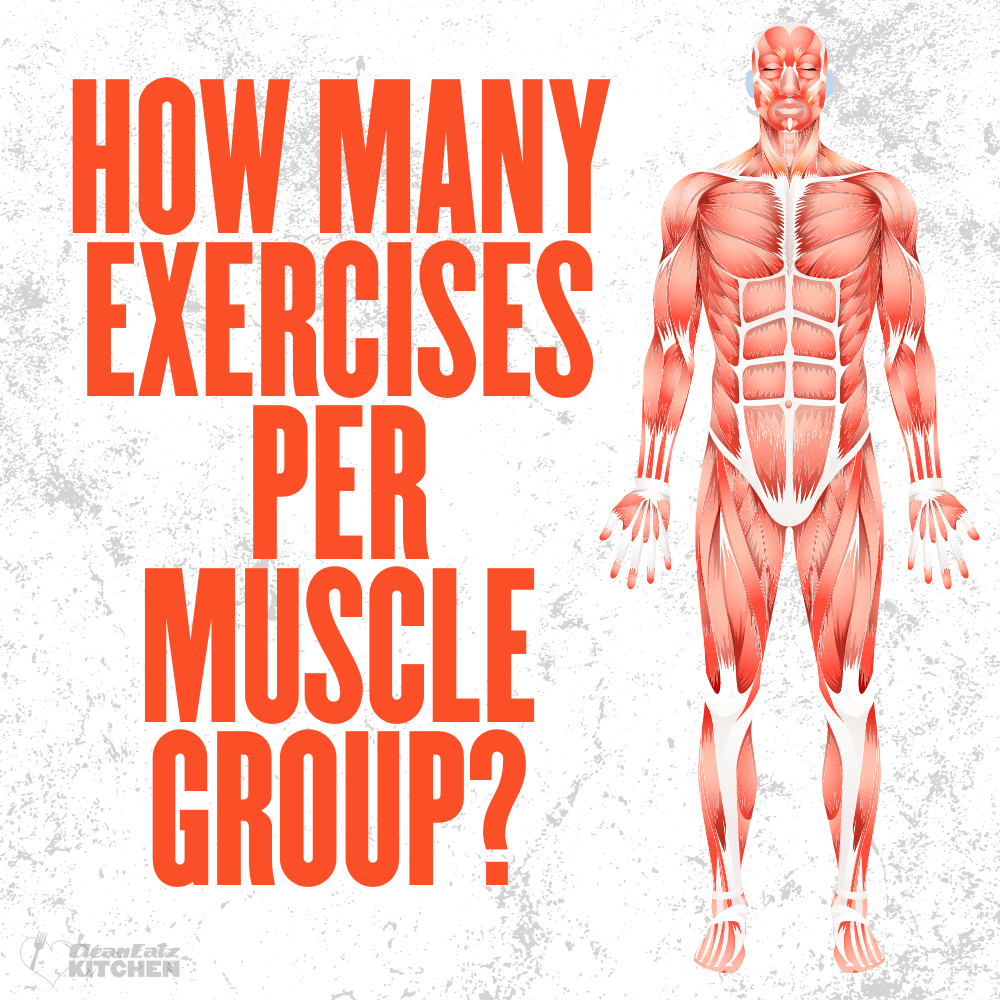
How Many Exercises Per Muscle Group?
Jason Nista
Exercises & Fitness
15 minute read
One of the biggest queries that every fitness enthusiast has to face at some point in their career is how many exercises per muscle group you need to do. The answer to that question, unfortunately, isn't a simple one. It depends on a variety of factors, including your fitness level, exercise experience, and goals.
In general, though, we recommend doing 3-4 exercises for each muscle group. This will allow you to target the muscle effectively and fatigue it by the end of the set. If you're a beginner, though, start with just 1-2 exercises and work your way up.
Exercises to Target Major Muscle Groups
When it comes to exercises, there are a few that target major muscle groups. These exercises should be done at least twice a week and on non-consecutive days. Three times a week is even better if you want to acquire better results over a short period of time.
How many exercises per muscle group do you need to do? The best exercises to target major muscle groups are squats, lunges, push-ups, pull-ups, and crunches. You can mix and match these exercises to create your own routine, or you can follow one of the routines provided by fitness experts.
What is the Optimal Amount of Exercises to Do?
To understand how many exercises you need to do per muscle group, you need to bring into consideration several factors, including your goals, experience level, and how much time you have to dedicate to working out each day.
Generally, 3-5 exercises per muscle group are ideal. But if you're just starting out, or if you don't have a lot of time to work out each day, then 2 exercises per muscle group is sufficient.
On the other hand, if you're an experienced exerciser and you have plenty of time to devote to your workouts, then 5-7 exercises per muscle group are optimal. This will allow you to work each muscle group from multiple angles, and achieve the best results.
How Many Exercises Per Workout Should You Choose?
Selecting the right number of exercises per workout hinges on your individual objectives. For instance, if muscle building is your goal, weightlifting exercises should be your focus. Conversely, for enhancing cardiovascular health, aerobic exercises are key.
However, the question persists: how many exercises per workout should one incorporate? This largely boils down to your preferences and the rigor of the exercises. While some favor fewer, high-intensity exercises, others lean towards a greater number of less-demanding exercises. As long as you're pushing your boundaries and advancing progressively, you're on the right track!
Workout Set-Up Varieties
Designing your workout starts with determining your desired set-up. The three predominant set-ups to consider are full-body, upper-body, and lower-body workouts.
A full-body routine engages all primary muscle groups, whereas an upper-body focuses on the chest, shoulders, and back. Conversely, a lower-body workout emphasizes the legs and glutes.
Each set-up offers distinct benefits. For instance, a full-body workout is preferable for those desiring a holistic approach, covering all major muscle groups and burning more calories. Upper-body workouts are tailored for muscle mass enhancement and are beginner-friendly. Lower-body workouts, targeting leg and glute toning, are also ideal for novices.
Why Divide Exercises Across Multiple Workouts?
If you're pondering "how many workouts should I do a day?", splitting your exercises into several sessions can be effective. By diversifying your routine into multiple mini-workouts, you enhance the frequency, thereby boosting the odds of witnessing improvements. Such a strategy also encourages commitment by making the regimen less overwhelming.
Moreover, segmenting exercises allows for focused attention on specific muscle groups, minimizing injury risks and bolstering your overall fitness.
How Many Exercises Per Workout and Their Sets & Reps
The number of sets and reps you integrate into each exercise determines the efficiency of your workout. If you're aiming to build muscle, you'll want to include more exercises per workout that involve more sets with fewer reps. For example, 4 sets of 6 reps for each exercise. Conversely, if you're focused on endurance, you might prioritize exercises that require 2 sets of 12 reps.
The variety in how many exercises per workout you can include is vast. Ultimately, you should determine the most suitable combination for yourself. A general guideline is: more reps with fewer sets enhance endurance, while more sets with fewer reps facilitate muscle growth.
The Significance of Intervals and Recovery
Before increasing the frequency of how many workouts you should do a day, comprehend the essence of rest and recovery. When exercising, your muscles undergo minor strains.
This microtrauma, while initially alarming, facilitates muscle growth. However, for muscles to mend and become stronger, adequate rest periods are crucial. This means if you're considering how many workouts you should do a day, ensure there's a day of rest between intense sessions targeting the same muscle group. On your resting days, you can indulge in milder exercises.
Ultimately, the key lies in customizing according to personal needs. If uncertain about how many exercises per workout are ideal, or how many workouts you should do a day, experiment and adjust based on results. Consistency is pivotal for noteworthy outcomes.
Benefits of Doing Fewer Exercises Per Muscle Group
When it comes to how many exercises you should do per muscle group, there are a lot of differing opinions out there. Some people think that you should do as many as possible, while others believe that doing fewer exercises is better.
The answer is that doing fewer exercises is much preferred since when you do more exercises per muscle group, you're not only working that muscle group harder, but you're also working other muscle groups too. This can lead to imbalances and injuries in the long run.
On the other hand, if you do fewer exercises per muscle group, you're able to focus more on quality than quantity. You can really fatigue the muscle and make sure that each rep is effective. Not only will this help you see better results, but it'll also help prevent injuries.
Volume, Intensity Frequency, and Rep Ranges
Let’s first start by explaining a couple of concepts to take into consideration so you can understand exactly how many exercises per workout you need to do to reach your goals:
- Volume: This refers to how much you do every week expressed in sets and reps per major muscle group. For example, bench pressing, incline bench pressing, chest flies and pushups are all exercises for your horizontal pushing muscles, chest, triceps, and front delts so all the sets you perform in a week of all those exercises added up are the volume of work you’re doing for your pushing muscles.
- Intensity: basically means how difficult or “intense” the exercise is and how big the demand it places on your body to cause and stimulate a desired adaptation, When lifting weights the best measure for the intensity of the exercise is the weight that you lift, meaning that heavier weight is higher intensity and lower weight is lower intensity. As a general rule, when the intensity goes up the volume will need to go down to prevent over-burning and injuries, and also to ensure you maintain proper form of execution on every rep of every exercise.
- Frequency: refers to how often you train a major muscle group or body part. Common training programs that entail training one muscle group per week have a lower frequency than training programs that are full-body every single day. However, research shows that the most important aspect here is total weekly volume and it doesn’t make much difference if you get all your sets and reps for a specific muscle group in one single session or several spread through the week.
- Rep ranges: When planning your workout exercises, sets, and reps, it's crucial to understand the concept of rep ranges. Rep ranges refer to the number of repetitions you perform in each set and are determined based on your specific fitness goals. This concept is part of what's known as the strength-endurance continuum. Lower rep ranges, typically around 3-5 or 4-6 repetitions, are ideal for those aiming to achieve faster strength gains. In contrast, rep ranges in the middle of the spectrum, such as 6-10 or 8-12 repetitions, are best suited to stimulate maximum muscle growth. On the other hand, higher rep ranges (12+ reps) are more efficient at building muscle endurance and resistance. Importantly, these rep range goals are not mutually exclusive, meaning you can build muscle with lower rep ranges and develop some strength with higher rep ranges. It's all about tailoring your workout sets and reps to align with your specific fitness objectives and finding the right balance within this continuum.
Choosing the Right Exercises for Each Muscle Group
Now that you know how many exercises you should do for each muscle group, you’ll need to decide which ones are best for you. Generally, compound exercises like the squat, deadlift, and bench press are a great way to work multiple exercise muscle groups at once and get the most bang for your buck.
On top of that, isolation exercises that target one muscle group can be great too. This includes bicep curls, tricep presses, leg extensions, and lateral raises. It's a good idea to mix it up every few weeks and switch up some of the exercises so your body doesn't become too accustomed to one particular routine.
Remember to also focus on form over weight when selecting exercises; no matter what exercise it is, if your form isn't right, you won't get the maximum benefit out of it. Take your time here – knowing which ones are best for each muscle group will make all the difference!
The Importance of Rest and Recovery Between Sets
It's also important to factor in rest and recovery time between sets for each muscle group. The more you work on a particular muscle, the more you will benefit from taking breaks between sets. This is because when you exercise, you are breaking down muscle fibers, and in order to build stronger, denser muscles, your body needs a period of rest and recovery in order to heal itself and rebuild the tissue.
When rest and recovery are combined with nutrition as part of a well-rounded fitness program, they can help promote better gains in lean muscle mass, improved strength and power gains, improved recovery time, and reduced risk of injury. So be sure to give your body the time it needs for proper rest and recovery between sets for maximum benefit!
You probably can't do just one set of exercises for each muscle group and expect results. Depending on your fitness level, you might need to do two or three sets. This will help you achieve the level of fatigue that's necessary for muscle growth.
Doing the right exercises is important, but how many you do is just as critical. So, if you're looking to gain muscle size and strength, aim to do two or three sets of each exercise. Just make sure you're giving each set your all so that you're really fatiguing the muscle.
If you’re just entering the world of exercise, then you must also understand that there are several ways that you can utilize to make your exercise routine more effective. The most preferable for these is simply following the right diet plan. Clean Eatz Kitchen brings you a huge variety of delicious and nutritious meal plans to keep you going strong through all your workout sessions.
Building Your Perfect Workout Routine
So if you’re a bit confused about how to use all of this information, don’t worry you’re not alone. We’ll try to make it a bit clearer with a short summary, some examples, and some parting tips:
Define how many days a week you can realistically train: whether you train 3 days a week, 4 or 5 days, or even more make sure that it is something sustainable that you can stick to for at least a few months so you can see the real benefits of your training program. If you’re a beginner you can stay on the lower end and train 3 or 4 days a week, so your training volume should be spread out during those days. For example take pushing exercises like bench presses, incline bench presses, and pushups. You could do 12 sets per week spread in 3 days like this:
You could do 4 sets of bench pressing on Monday, 4 sets of incline bench pressing on Wednesday, and 4 sets of push-ups on Friday. Then do the same for pulling exercises and leg exercises and you have 3 full body routines a week.
Or if you decide to train each muscle group or body part once a week you can do your pressing on Mondays with 4 sets of bench pressing, 3 sets of overhead pressing, 3 sets of chest flies, and 1-2 sets of pushups. Then Wednesday can be devoted to pulling exercises and Friday to training your legs.
Decide which exercises to do: As we’re focusing on gaining strength and building or maintaining muscle, your time at the gym would be better spent focusing the majority of your effort on compound lifts that allow you to lift the most weight in a safe manner. We already saw some good exercises for pressing with the bench press, overhead press, and push-ups, which can be supplemented with some triceps and shoulder isolation exercises. For pulling you can’t go wrong with deadlifts, rows, and pull-ups plus some curls for your biceps, and for legs, you should focus on squats, lunges, and leg presses.
Rep ranges: As mentioned before when intensity is higher volume should go down. So for big compound movements like squats, deadlifts, and bench or overhead pressing, which again should be the main focus, you should stay on lower rep ranges like 3-5 or 4-6 reps per set, and for isolation or accessory exercises like curls, tricep extension, shoulder flies or leg curls you can do sets of 6-10 or 8-12 reps. These ranges mean that you should lift a weight that allows you to lift the lower end of the range, for example for 4-6 a weight that allows you to perform 4 reps with good form on every set, then continue adding reps every workout exercises, and once you’re able to get to the high end, in this case, 6, you can add some weight for your next session and go back down to the low end, in this case, 4. Keep in mind that you should not train to failure as it has not been shown to be more beneficial for strength and muscle gains, but only takes you closer to injuries, so make sure you have one or two good reps in the tank before finishing your set.
Rest periods and recovery: You should feel recovered after every set before the next one to make sure you get all the reps and continue getting stronger. The recommended rest time for heavy lifts is 2-3 minutes up to even 5 minutes, and for higher rep range and lighter weight exercise, 1 to 2 minutes should be plenty.
Nutrition: All the effort in the gym and all the exercises in the world can not compensate for not giving your body enough nutritious foods to grow stronger, repair itself, and help you achieve your goals. Remember the general guidelines of getting plenty of nutritious whole foods, lots of colorful vegetables, also a lot of protein, which is as important for building muscle as for maintaining it when on a caloric deficit to lose fat. If you’re not sure how to do this you can check our great resources and articles here or you can make your life easier by allowing us to guide you through the process with our amazing meal plans.
Final Thoughts
So how many exercises per muscle group do you need to do. You need to perform exercises that target major muscle groups of your body. 3-5 exercises per muscle group are ideal, but you can increase this to 5-7 for better results. Diving your exercises through various muscle groups can help you prevent injuries. You can try mixing up different types of exercises to see what works best for you. Remember to take breaks to allow your muscles to rest and recover.
FAQ
Is it better to perform more sets or more exercises for a muscle group?
It's a matter of preference and individual goals. Some people prefer to do more sets of fewer exercises, while others like to incorporate a variety of exercises with fewer sets each. Both approaches can be effective, as long as you're progressively overloading the muscles and ensuring proper form.
Should beginners do fewer exercises than advanced lifters?
Beginners can start with a simpler workout routine that includes fewer exercises and gradually adds more complexity as they gain experience and strength. Advanced lifters may benefit from more exercises to target specific areas or break through plateaus.
Do different exercises provide different benefits for muscle growth and strength?
Yes, different exercises target muscles in slightly different ways and can provide varying benefits. For well-rounded muscle development, it's often recommended to include a mix of compound and isolation exercises in your routine.
Should I consult a fitness trainer or coach to determine the right number of exercises for me?
If you're unsure about the number of exercises per muscle group or need a personalized workout plan, consulting a fitness trainer or coach can be highly beneficial. They can assess your goals, fitness level, and preferences to create an effective and tailored program.
Can I do a full-body workout with just a few exercises?
Yes, a full-body workout can be effective even with a limited number of exercises. Choose compound movements that engage multiple muscle groups simultaneously to get the most out of your full-body routine.
Related Articles
How Often Should You Do Hip Mobility Exercises?
7 minute read
How To Make the Most of a Home Gym and Limited Space
6 minute read
Does Aerobic Exercise Increase Mitochondria?
12 minute read



